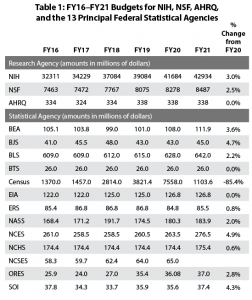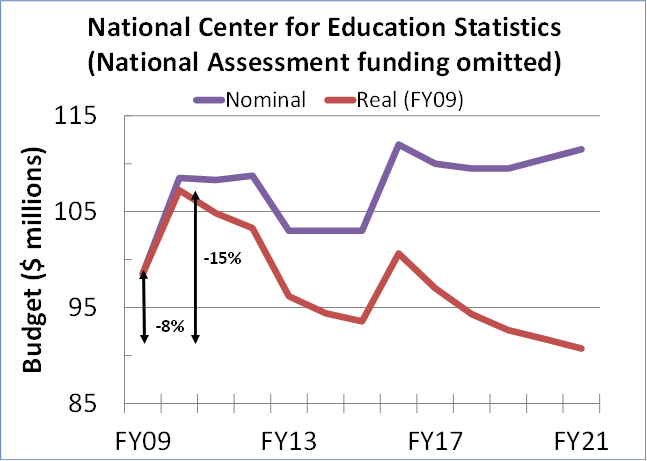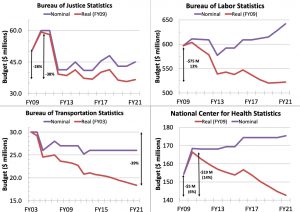FY21 Federal Budget Finalized
Steve Pierson, ASA Director of Science Policy
Congress and the Trump administration finalized the federal government’s fiscal year 2021 (FY21) budgets in the waning days of 2020, nearly three months after the start of the fiscal year. The National Institutes of Health (NIH), National Science Foundation (NSF), and several federal statistical agencies received increases of a few percent, which is encouraging support in the current fiscal environment (see Table 1).

The FY16–FY21 budgets for NIH, NSF, AHRQ, and the 13 principal federal statistical agencies, including percentage increases over prior year for finalized FY21 budgets. The NCHS budget was restructured in FY21 to include $14 million that had been regularly provided through a public fund. The FY16–FY20 budgets were adjusted to make the levels comparable of the years. Relocation costs for BLS in FY20 and FY21 are not included above. FY21 figures are estimates.
Many of the statistical agencies are nonetheless facing fiscal challenges after years of purchasing power loss as they seek to address ever-present difficulties, including measuring a dynamic economy, population, or societal conditions; declining response rates; and modernizing to take advantage of technological, methodological, and other advances (e.g., increasing data availability and data-linking opportunities).
The increase of $1.25 billion for NIH sustains a remarkable bicameral, bipartisan run of six straight years of at least such increases, resulting in 42 percent growth in the NIH budget since FY15. Congress also supported the administration’s requested increases for the economic statistical agencies, which the administration proposed in recognition of the importance of “economic statistics for businesses and everyday citizens to make informed decisions and confidently invest in America’s future.” Specifically, the budget for the Bureau of Economic Analysis (BEA) increased $3.9 million (3.6 percent) to $111.9 million and the budget for the Bureau of Labor Statistics (BLS) increased $14 million (2.2 percent) to $642 million. An additional $13 million was provided for the BLS to relocate from its current location in Washington, DC, to Suitland, Maryland, where it will be co-housed with the US Census Bureau and BEA.
Congress also included in the report language accompanying the appropriations bills guidance regarding agencies that have been a focus of ASA advocacy: National Center for Education Statistics (NCES); Bureau of Justice Statistics (BJS); and USDA Economic Research Service (ERS). Specifically, lawmakers stated they are “deeply concerned about the ongoing staffing crisis at NCES” and requested “a report outlining how the department will increase staffing at NCES” and an analysis exploring ways to give NCES more control over its allocated budget. They also directed the BJS “to release data in a timely manner and in accordance with its publication calendar.” Regarding the ERS and sister USDA agency National Institute for Food and Agriculture (NIFA), lawmakers requested the National Academies “conduct symposia to elucidate the effects of the relocation of each agency.” This refers to the 2019 relocation of the ERS and NIFA from Washington, DC, to Kansas City, Missouri. The House report language stated, “The loss of institutional knowledge [ERS] has suffered will take years to overcome.”
![Figure 1 shows the budgets of the seven mid-sized statistical agencies normalized to their FY09 levels, along with the GDP deflator to account for inflation. Budget restructuring for ERS in FY15 and ORES in FY19 are accounted for in the graph to allow for comparison over this time period. One-time moving costs in FY16 for BEA are also omitted. [Key: BEA, Bureau of Economic Analysis; BJS, Bureau of Justice Statistics; BTS, Bureau of Transportation Statistics; ERS, USDA Economic Research Service; NCSES, NSF National Center for Science and Engineering Statistics; ORES, Social Security Administration Office of Research, Evaluation, and Statistics; SOI, IRS Statistics of Income Division]](https://magazine.amstat.org/wp-content/uploads/2021/02/FY_Figure1_-300x214.jpg)
Figure 1: The budgets of the seven mid-sized statistical agencies normalized to their FY09 levels, along with the GDP deflator to account for inflation. Budget restructuring for ERS in FY15 and ORES in FY19 are accounted for in the graph to allow for comparison over this time period. One-time moving costs in FY16 for BEA are also omitted. [Key: BEA, Bureau of Economic Analysis; BJS, Bureau of Justice Statistics; BTS, Bureau of Transportation Statistics; ERS, USDA Economic Research Service; NCSES, NSF National Center for Science and Engineering Statistics; ORES, Social Security Administration Office of Research, Evaluation, and Statistics; SOI, IRS Statistics of Income Division]
![Figure 2 shows the budgets of five larger statistical agencies normalized to their FY09 levels, along with the GDP deflator to account for inflation. Census is omitted because of the large changes in the decennial census cycle. Budget restructuring for NASS in FY15 and NCHS in FY15 and FY21 are accounted for in the graph to allow for comparison over this time period. Relocation funding for BLS is omitted. [Key: BLS, Bureau of Labor Statistics; EIA, Energy Information Administration; NASS, National Agricultural Statistics Service; NCES, National Center for Education Statistics; NCHS, National Center for Health Statistics]](https://magazine.amstat.org/wp-content/uploads/2021/02/FY_Figure2-300x212.jpg)
Figure 2: The budgets of five larger statistical agencies normalized to their FY09 levels, along with the GDP deflator to account for inflation. Census is omitted because of the large changes in the decennial census cycle. Budget restructuring for NASS in FY15 and NCHS in FY15 and FY21 are accounted for in the graph to allow for comparison over this time period. Relocation funding for BLS is omitted. [Key: BLS, Bureau of Labor Statistics; EIA, Energy Information Administration; NASS, National Agricultural Statistics Service; NCES, National Center for Education Statistics; NCHS, National Center for Health Statistics]
While most statistics agencies received modest increases for FY21, the story is concerning when one considers their budgets over the last dozen years. As shown in Figures 1 and 2, all but three of the 12 agencies have lost purchasing power since FY09.
For four of the agencies, the loss of purchasing power is greater than 12 percent. The loss of purchasing power due to inflation is further illustrated in Figure 3, where the loss is even larger for the BJS and National Center for Health Statistics (NCHS) when compared to FY10. In the case of BJS, the larger funding in FY10 and FY11 is likely due to short-term investments to improve the National Crime Victimization Survey, which may at least partially explain the steep drop in FY12.
The large increase in the budget for the National Center for Science and Engineering Statistics (NCSES) in FY14 and FY15, as observed in Figure 1, is almost—if not entirely—due to enhancements to the Survey of Doctorate Recipients that increased the sample size from 47,000 to 120,000. In fact, as explained in a June 2020 Amstat News article, the NCSES still faces many of the budget challenges as the other agencies despite the increase. To that point, an ASA analysis found NCSES has a budget to staff ratio of $1.1 million per full-time staff member, which is more than three and a half times the median of the 13 principal federal statistical agencies—second only to NCES.
A closer inspection of the NCES budget manifests a 20 percent loss in purchasing power in the statistics budget since FY09—15 percent since FY10—as seen in Figure 4 FY09—25 percent since FY10—as seen in Figure 4. Its tight budget and staffing crisis have led NCES to cut or cut back on programs, as described in another June 2020 Amstat News piece.
As a result of the purchasing power loss, many of these agencies are struggling to track emerging trends and take advantage of methodological and technological advances that would help the agencies improve data and reduce costs and respondent burden.

Figure 41: The NCES statistics budget in nominal and inflation-adjusted (i.e., real) dollars, showing the $8 million loss in purchasing power since 2009. Data source: Statistical Programs of the United States Government, OMB, FY11-FY20
An administration’s budget request for the coming fiscal year is usually released the first Monday of February. With a change in administration underway, the first budget request of the Biden-Harris administration is not expected until at least April. The ASA will summarize the FY22 requests for NIH, NSF, AHRQ, and the statistical agencies in an Amstat News article and track FY22 appropriations developments in blog posts.


















